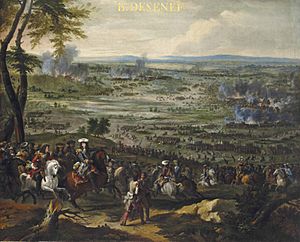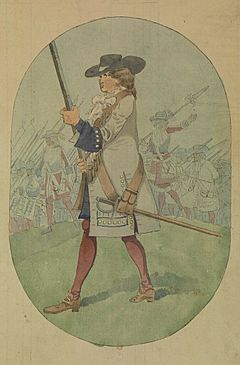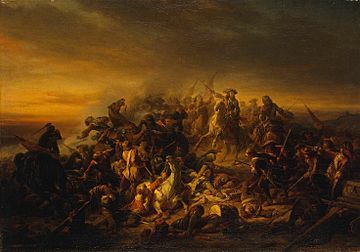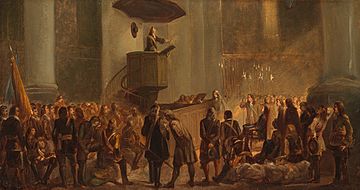Battle of Seneffe facts for kids
Quick facts for kids Battle of Seneffe |
|||||||
|---|---|---|---|---|---|---|---|
| Part of the Franco-Dutch War | |||||||
 Battle of Seneffe, 11 August 1674 |
|||||||
|
|||||||
| Belligerents | |||||||
| Commanders and leaders | |||||||
| Strength | |||||||
| 45,000-50,000 men 60 guns |
60,000-65,000 men 70 guns |
||||||
| Casualties and losses | |||||||
| c. 10,000 | c. 15,000 | ||||||
The Battle of Seneffe was a major fight during the Franco-Dutch War. It happened on August 11, 1674, near a town called Seneffe in what is now Belgium. The battle was between the French army, led by the famous Prince de Condé, and a combined army from the Dutch, the Holy Roman Empire, and Spain. This combined force was led by William of Orange.
It was one of the most intense and bloody battles of the war. More than 20% of all the soldiers involved were either killed or wounded. Because both sides fought so hard and neither gained a clear win, historians still debate who truly won the battle.
In 1674, the Allied forces in the Spanish Netherlands were larger than the French army. William of Orange wanted to attack the French, but the difficult land made his army split into three groups. Condé, the French commander, saw this as a chance to attack. He launched a surprise cavalry attack, stopping the Allied advance. However, Condé then ordered more attacks that led to huge losses for both sides. The fighting lasted until nightfall. Condé pulled back, and William's army also moved away the next day.
Neither side got a clear advantage. William quickly rebuilt his army, while the French king, Louis XIV, told Condé to focus on capturing towns instead of fighting big battles.
Why the Battle Happened
Both France and the Dutch Republic wanted control over the Spanish Netherlands (modern-day Belgium). This area was important for their safety and trade. France had taken over much of it in an earlier war, but a group of countries, including the Dutch, forced France to give most of it back. Because of this, the French king, Louis XIV, decided he needed to defeat the Dutch first to get what he wanted.
The Franco-Dutch War started in May 1672. French troops quickly took over many parts of the Netherlands. But by July, the Dutch managed to stop the French advance. Louis XIV had asked for too much, and other countries became worried about France's growing power. So, Brandenburg-Prussia, Emperor Leopold, and Charles II of Spain joined the Dutch side. By August 1673, a large army from the Holy Roman Empire entered the region. Facing war on many fronts, Louis XIV pulled most of his troops out of the Netherlands.
In January 1674, Denmark–Norway also joined the countries fighting France. Then, in February, a peace treaty ended the Third Anglo-Dutch War, meaning France lost an important ally against the Dutch. In May, the French attacked the Spanish region of Franche-Comté. Meanwhile, Condé stayed on defense in the Spanish Netherlands. A combined Dutch-Spanish army, led by William of Orange, tried to force Condé into a battle, but he avoided it.
William then suggested invading French Flanders, which would threaten Condé's army from behind and force him to fight. The Spanish agreed, hoping to recapture the important town of Charleroi. By early August, Condé had about 45,000 soldiers ready for defense along the Piéton river.
The Allied army decided Condé's defenses were too strong for a direct attack. So, on August 9, they moved their army to try and get around Seneffe and behind the French lines. This would cut off Condé's supplies and trap the French soldiers in Charleroi.
The Battle Begins
At 4:00 AM on August 11, the Allied army started marching in three separate groups. They had to march this way because the roads were very bad. The left group was led by de Souches, the right by the Marqués de Assentar (the Spanish commander), and the main group with most of the foot soldiers and cannons was in the middle, led by William.
Condé, the French commander, heard the Allies were moving. By 5:30 AM, he rode out to see what they were doing. He quickly understood their plan. The land they were crossing was wet and uneven, with many hedges, walls, and woods. Condé decided to attack, believing these obstacles would make the Allies' larger numbers less effective. He sent light cavalry to slow down the Allied army and another cavalry group to take high ground near Seneffe.
Around 10:00 AM, the French cavalry met the Allied rearguard. Condé himself, despite suffering from gout (a painful joint condition), led his best cavalry units across the Zenne river. They quickly scattered the Allied cavalry, which caused some confusion among the Spanish troops behind them.
The French, led by duc de Luxembourg, attacked the Allied foot soldiers in Seneffe. They either killed or captured them. By midday, Condé had caused significant damage and won a small victory. However, he then made a risky decision. Against the advice of his officers, he ordered more direct attacks. This led to many confused and costly fights.
William stopped his march and set up a strong defensive line, mostly with Dutch foot soldiers, around the Priory of St Nicolas. To the north, Assentar gathered the cavalry that had fled and brought them back into the fight. They were pushed back twice, but the French attacks on the priory were also stopped with heavy losses. When Assentar was badly wounded, his cavalry retreated, running over their own foot soldiers. This allowed the French to capture the priory. Condé himself led this last attack and was almost captured but was saved by his son. After taking St Nicolas, the French also captured much of the Allied supplies.
The fighting around the priory gave William and his commanders time to set up a new defensive line at Fayt. This line had 23 Dutch battalions. Condé thought the Allies were retreating and planned to attack them from behind. However, William turned Fayt into a very strong defensive position, placing cannons along the roads and hedges. The French had trouble attacking because the ground was not good for cavalry, and their heavy cannons were left behind.

Condé ordered his generals, Luxembourg and Navailles, to attack the Allied sides, while he attacked the village with his best French and Swiss soldiers. These attacks continued all afternoon, but each time they were pushed back with many losses. At one point, some French soldiers got into the village and captured six Dutch cannons, but the Allies quickly took them back.
On the French right side, Luxembourg's attack was delayed because his soldiers were busy taking supplies from the captured baggage train. He eventually attacked but was pushed back. Around 5:00 PM, Condé realized Luxembourg's men were tired and told them to stop attacking and defend their positions.
On the French left, Navailles' repeated attacks on the Dutch positions were also stopped. Although some French troops finally broke through around 7:00 PM, William quickly moved his cavalry forward and restored the line after tough fighting. Two hours later, Condé finally stopped all attacks, though small fights continued.
Many soldiers slept on the battlefield. Both armies stayed in position, expecting to fight again the next morning. But a sudden burst of gunfire broke out around midnight, killing soldiers on both sides. Once it was calm again, Condé ordered his troops to go back to Charleroi. William wanted to chase them, but his commanders disagreed. Instead, William ordered his troops to fire their guns three times to claim victory, then he moved his army to Mons.
What Happened Next
After the battle, both sides claimed victory because they had "held their ground." But in reality, neither side gained a clear win, and the overall situation in the war didn't change much. Condé didn't make the most of his early success, and his later attacks were costly. Historians still disagree on who won, calling it a French victory, an Allied success, or simply undecided.
Many soldiers were lost on both sides. Estimates say the Allies lost between 10,000 and 15,000 soldiers, including prisoners. Important officers like Sir Walter Vane and Assentar were killed. French losses were between 7,000 and 10,000 dead or wounded, with many officers among them. The French court was shocked by the losses. One person wrote, "We have lost so much by this victory that without the Te Deum and captured flags... we would believe we had lost the battle." A French military expert, Sébastien Le Prestre de Vauban, suggested that capturing towns was better than fighting such costly battles. So, King Louis XIV told Condé to avoid similar big battles in the future.
Even though the Allies lost more soldiers, they quickly replaced them with troops from nearby garrisons. Also, a large convoy arrived with supplies and new Dutch regiments. Condé couldn't replace his losses as easily, so the Allies actually had a bigger army after Seneffe than before. William wanted to try another invasion.
However, the French had one advantage: a single leader and a clear plan. The Allied commanders often disagreed. William's allies didn't want to risk another battle. So, William had to agree to besiege (surround and attack) the town of Oudenarde. The attack started on September 16. Condé began marching to help Oudenarde. The Dutch and Spanish tried harder to break through the town's walls before Condé arrived. But without telling his allies, de Souches sent the Imperial cannons away. When Condé arrived, the Allies couldn't fight without their cannons, and they were forced to give up the siege, leaving most of their equipment behind.
After strong complaints from the Dutch government, de Souches was removed from his command. But the problem of different goals remained. Emperor Leopold wanted to focus on another area, the Spanish wanted to get back their lost lands, and the Dutch wanted to recapture their towns of Grave and Maastricht.
So, the Spanish troops went back to their garrisons, and the Imperial troops crossed the Meuse river. William took command of the operations at Grave. This town had been under attack since June 28 and finally surrendered on October 29. Condé received a grand welcome at Versailles for Seneffe, but his health was getting worse, and Louis XIV trusted him less because of the high casualties. Condé later led French troops in another area for a short time but retired before the end of the year. In the long run, Seneffe showed Louis XIV that attacking towns and careful troop movements were better ways to win wars than big, costly battles.
The battles of Seneffe and Grave showed how the war had changed. Two years after France had taken over much of the Dutch Republic, the war became a long struggle where both sides were strong, but neither was ready to make peace.
See also
 In Spanish: Batalla de Seneffe para niños
In Spanish: Batalla de Seneffe para niños
Images for kids











